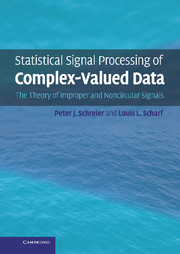Preface
Published online by Cambridge University Press: 25 January 2011
Summary
Complex-valued random signals are embedded into the very fabric of science and engineering, being essential to communications, radar, sonar, geophysics, oceanography, optics, electromagnetics, acoustics, and other applied sciences. A great many problems in detection, estimation, and signal analysis may be phrased in terms of two channels' worth of real signals. It is common practice in science and engineering to place these signals into the real and imaginary parts of a complex signal. Complex representations bring economies and insights that are difficult to achieve with real representations.
In the past, it has often been assumed – usually implicitly – that complex random signals are proper and circular. A proper complex random variable is uncorrelated with its complex conjugate, and a circular complex random variable has a probability distribution that is invariant under rotation in the complex plane. These assumptions are convenient because they simplify computations and, in many aspects, make complex random signals look and behave like real random signals. Yet, while these assumptions can often be justified, there are also many cases in which proper and circular random signals are very poor models of the underlying physics. This fact has been known and appreciated by oceanographers since the early 1970s, but it has only recently been accepted across disciplines by acousticians, optical scientists, and communication theorists.
This book develops the tools and algorithms that are necessary to deal with improper complex random variables, which are correlated with their complex conjugate, and with noncircular complex random variables, whose probability distribution varies under rotation in the complex plane.
Information
- Type
- Chapter
- Information
- Statistical Signal Processing of Complex-Valued DataThe Theory of Improper and Noncircular Signals, pp. xiii - xviPublisher: Cambridge University PressPrint publication year: 2010
